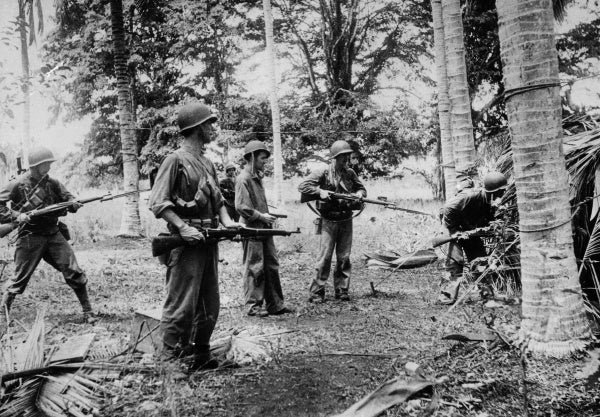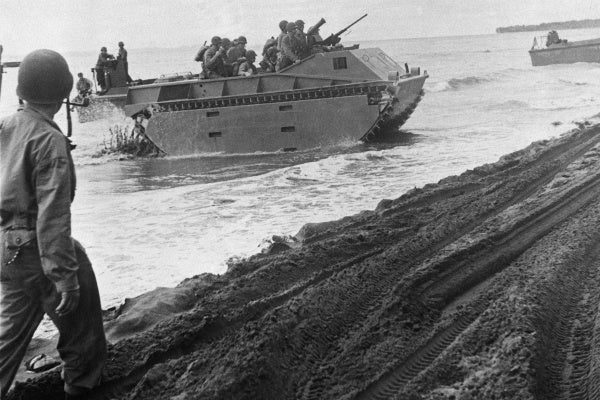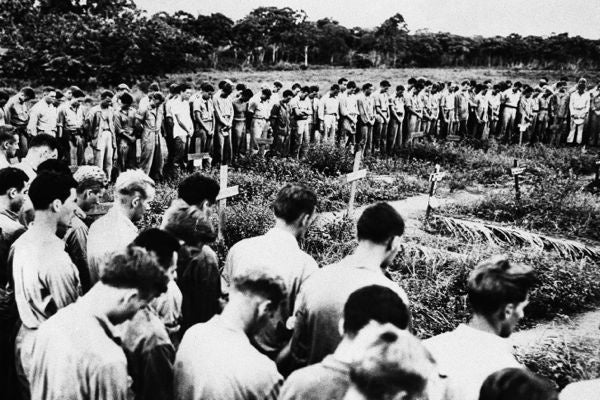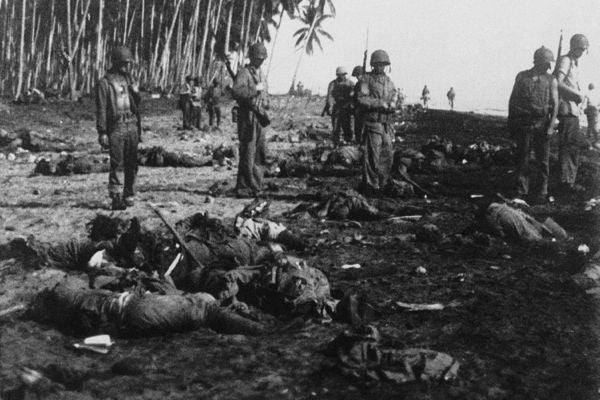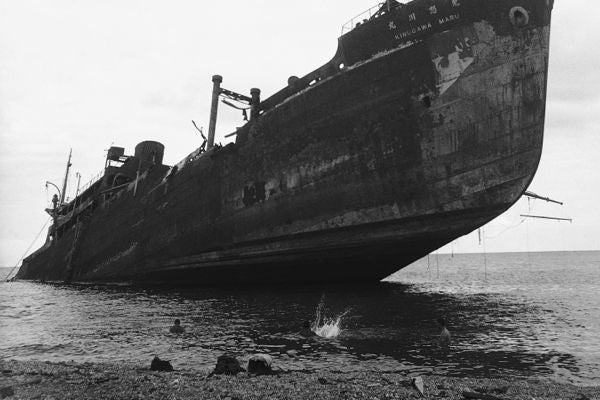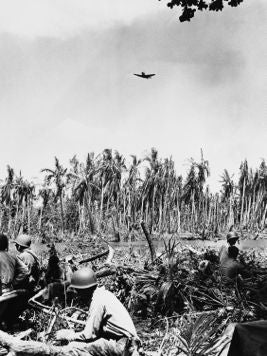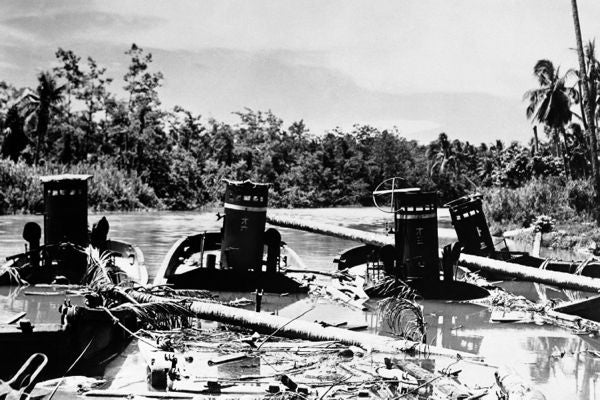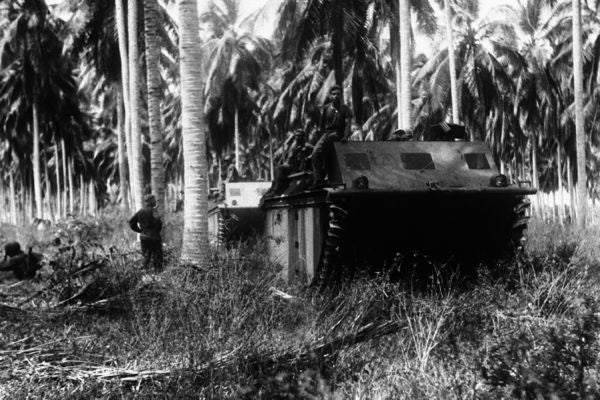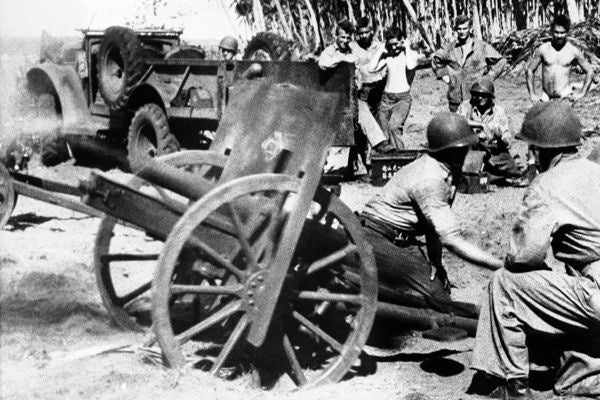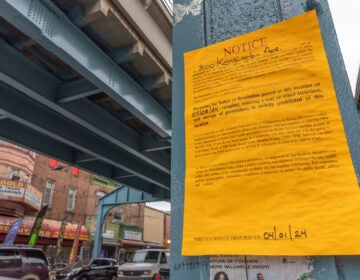The epic struggle for Guadalcanal
A lifetime ago a struggle began that would help shape the world for decades to come. The ranks of the men who served there are thinning rapidly now, perhaps a few thousand remaining among the tens of thousands of Americans who came to bloody grips with the foe on land, at sea, and in the air in a place that not one in a hundred among them had ever heard of before. But their fight should never be forgotten, because the campaign they began against the Japanese Empire 70 years ago today – August 7, 1942, at a place called Guadalcanal – marked a turning point in the war.
The summer of 1942 was the highwater mark of conquest for the Axis powers of Germany, Italy and Japan.
After their initial failure to knock out the Soviet Union in 1941, Nazi panzer divisions were again rolling through southern Russia, sweeping aside all in their path as they drove for the strategically vital oilfields of the Caucasus. German and Italian troops under the command of General Erwin Rommel had pushed British forces in Egypt back to within less than a hundred miles of Alexandria and the Suez Canal. U-boats were sinking half a million tons of shipping each month in the Atlantic. In addition to much of China, which it held from before the war started, the Japanese Empire now controlled millions of square miles and many more millions of people taken in its whirlwind conquests of the Philippines, Burma, Malaya, and the Dutch East Indies in the first half of 1942. For the Allies it was the darkest hour of the war.
Their pushback started in the unlikeliest of spots.
The Worst Place on Earth
Guadalcanal is one of the Solomon Islands chain in the Southwest Pacific that lie north and east of Australia. In 1942 it was mountainous, covered in stinking, disease-ridden, almost impenetrable jungle, subject to tropical heat and continual rain. Everyone who fought there, American and Japanese alike, thought that it was the worst place they’d ever seen. But it had one thing to attract the eye of military strategists: an abandoned rubber plantation near its northeast coast. There, the ground was firm and dry enough that an airfield could be built.
The Japanese began constructing an airbase there in the spring of 1942. When completed it would help them extend their conquests further down the island chains and isolate Australia, the main Allied base in the Southwest Pacific. The U.S. was determined to keep that from happening. The result was the first Allied offensive in the Pacific.
A hastily-gathered convoy of whatever troops and ships could be assembled (the effort was known officially as “Operation Watchtower” but unofficially as “Operation Shoestring” among its planners) set sail for the island and dropped anchor there on August 7. The 1st Marine Division landed and took the unfinished airstrip, Japanese construction workers fleeing for the jungle.
Things rapidly took a turn for the worse for the Americans when the Japanese responded. Two nights later the U.S. Navy received its worst-ever defeat in a fleet action. At the Battle of Savo Island, four Allied cruisers guarding the northern approaches to the island were sunk in a matter of minutes by an attacking Japanese cruiser force that suffered virtually no damage to itself. That disaster, coupled with fighter plane losses among the aircraft carriers that were guarding the convoy, caused the American admiral in charge to withdraw his ships with much of the Marines’ supplies still unloaded. Until reinforcements could be gathered and delivered the 1st Marine Division was on its own.
The Marines almost annihilated the first small Japanese detachment landed on the island that tried to retake the airfield, which when completed in late August became known as Henderson Field after a Marine pilot killed at the Battle of Midway. Both sides knew that whoever controlled the airfield would ultimately control the battle.
A Three-dimensional battle
The see-saw struggle for Henderson Field that followed was unlike anything ever seen before: a three-dimensional battle on land, at sea, and in the air. And there was nothing predetermined about the outcome.
The U.S. and Japan were like two boxers each trying to land a punch at the very limits of their reach, for Guadalcanal was a long way from the major bases of each side. Neither could deliver a knockout blow, but they kept jabbing at one another in a fight that neither was willing to concede.
By day American and Japanese planes dueled in the sky over the field. The airfield and its planes – the “Cactus Air Force,” so-called because of the field’s code name “Cactus” – enabled the Americans to control the waters around the island during the day, when they could land reinforcements and supplies. The night was another story.
Japanese convoys that the Americans dubbed the “Tokyo Express” came down the channel through the Solomons on periodic nighttime runs to deliver their own supplies and ever-growing numbers of troops to Guadalcanal, and bombard Henderson Field with heavy gunfire. Whenever the U.S. Navy could muster sufficient force it tried to stop them.
Clashes by Night
As the Americans learned to their cost, Japanese naval night-fighting skills were the best in the world in 1942. In half a dozen major clashes and many smaller ones they gave at least as good as they got. The waters of idyllic-sounding Sealark Sound off Guadalcanal acquired another name: Ironbottom Sound, called so because of the more than 50 American and Japanese sunken ships that came to litter the ocean floor there. But at the cost of grievous losses of ships and sailors, in the three-day Naval Battle of Guadalcanal in November the U.S. Navy turned back the last major Japanese naval effort to land supplies and bombard Henderson Field.
On land, in scores of fierce skirmishes on nameless jungle trails and bitter night battles at places like Bloody Ridge that saw no-quarter, hand-to-hand fighting, the Marines repelled skillful and determined Japanese attacks. Japanese determination was often derided at the time as “fanaticism,” but as author William Manchester, in his youth a Marine who fought in the Pacific, later said, “In retrospect it is indistinguishable from heroism. To call it anything else cheapens the victory, for American valor was necessary to defeat it.”
‘Starvation Island’
The Marines held, and slowly, painfully, began to wrest the initiative from the Japanese Army. And as fewer and fewer supplies reached the Japanese there through an ever-tightening cordon thrown around the island by ever-increasing Allied air and sea power, they gave it a new name: “Starvation Island.”
Though the fighting had months to run after November, by then its outcome was basically decided. The losses in ships, planes, soldiers, and sailors they suffered at Guadalcanal and elsewhere throughout the Southwest Pacific during the campaign meant that the Japanese Army and Navy were never again able to regain the initiative in the Pacific War.
Elsewhere around the world in November, 1942, suddenly things began going the Allies’ way. British and American forces landed in North Africa and started the process of rolling up the Axis forces there from the west. Meanwhile, at the other end of the Mediterranean shore, British troops under the command of General Bernard Montgomery broke through Rommel’s defenses at El Alamein and began forcing them back toward the Allies advancing from the other direction. And a massive Soviet attack at a little-known town on the Volga River – Stalingrad – cut off the German 6th Army, whose survivors would surrender there in early February, just about the time that the Japanese were evacuating the last of their troops from Guadalcanal. Though years of bitter fighting lay ahead, the tide was turning.
In the brutal calculus by which such things are measured, Guadalcanal is a small thing next to Stalingrad, where hundreds of thousands of Russians and Germans were killed. Fewer than ten thousand American soldiers and sailors lost their lives on the island and the air and water surrounding it, and around thirty thousand Japanese.
But the Allied resurgence started there – a lifetime ago.
Karl Biemuller is an amatuer historian, astronomer, and writer in Mt. Airy.
WHYY is your source for fact-based, in-depth journalism and information. As a nonprofit organization, we rely on financial support from readers like you. Please give today.




